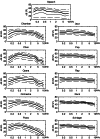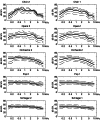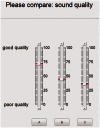Dynamic Range Across Music Genres and the Perception of Dynamic Compression in Hearing-Impaired Listeners
- PMID: 26868955
- PMCID: PMC4753356
- DOI: 10.1177/2331216516630549
Dynamic Range Across Music Genres and the Perception of Dynamic Compression in Hearing-Impaired Listeners
Abstract
Dynamic range compression serves different purposes in the music and hearing-aid industries. In the music industry, it is used to make music louder and more attractive to normal-hearing listeners. In the hearing-aid industry, it is used to map the variable dynamic range of acoustic signals to the reduced dynamic range of hearing-impaired listeners. Hence, hearing-aided listeners will typically receive a dual dose of compression when listening to recorded music. The present study involved an acoustic analysis of dynamic range across a cross section of recorded music as well as a perceptual study comparing the efficacy of different compression schemes. The acoustic analysis revealed that the dynamic range of samples from popular genres, such as rock or rap, was generally smaller than the dynamic range of samples from classical genres, such as opera and orchestra. By comparison, the dynamic range of speech, based on recordings of monologues in quiet, was larger than the dynamic range of all music genres tested. The perceptual study compared the effect of the prescription rule NAL-NL2 with a semicompressive and a linear scheme. Music subjected to linear processing had the highest ratings for dynamics and quality, followed by the semicompressive and the NAL-NL2 setting. These findings advise against NAL-NL2 as a prescription rule for recorded music and recommend linear settings.
Trial registration: ClinicalTrials.gov NCT02373228.
Keywords: compression; dynamic range; hearing aids; hearing loss; music genre.
© The Author(s) 2016.
Figures







References
-
- Ahnert, W. (1984). The sound power of different acoustic sources and their influence in sound engineering. Paper presented at Proceedings of the 75th Convention of the Audio Engineering Society, Preprint 2079. Retrieved from http://www.aes.org/e-lib/browse.cfm?elib=11685.
-
- Arehart, K. H., Kates, J. M., & Anderson, M. C. (2011). Effects of noise, nonlinear processing, and linear filtering on perceived music quality. International Journal of Audiology, 50(3), 177--190. - PubMed
-
- Bersch-Burauel, A. (2004). Entwicklung von Musikpräferenzen im Erwachsenenalter: Eine explorative Untersuchung [Development of musical preferences in adulthood: An exploratory study] (Doctoral dissertation). University of Paderborn, Germany.
-
- Boley, J., Danner, C., & Lester, M. (2010, November). Measuring dynamics: Comparing and contrasting algorithms for the computation of dynamic range. Paper presented at Proceedings of the 129th Convention of the Audio Engineering Society Convention 129. Retrieved from http://www.aes.org/e-lib/browse.cfm?elib=15601.
Publication types
MeSH terms
Associated data
LinkOut - more resources
Full Text Sources
Other Literature Sources
Medical

